|
< Earlier Kibitzing · PAGE 3 OF 3 ·
Later Kibitzing> |
| Dec-21-05 | | AlexanderMorphy: <KingG> when you say too much theory....how much exactly are we talking about here? 10-20 moves...even more? |
|
| Dec-21-05 | | KingG: <AlexanderMorphy> Assuming the 1800 player hasn't studied the Semi-Slav in detail(for example, assuming he doesn't play it himself), i would estimate he wouldn't know more than 10-15 in the Meran, 20 in the Botvinnik(which is nothing for this variation), and 10-15 in the Moscow variation. Of course if you play the Semi-Slav, you also need to know how to play the Exchange Slav(not very theoretical) and the 6.Qc2 lines(including the famous Shirov-Shabalov gambit). |
|
| Dec-21-05 | | alicefujimori: <Averageguy>To be honest, if one wants to play an opening regularly, he/she must study it in-depths before giving it a try. The Semi-Slav is actually a very exciting opening, but there are a lot of lines where you could lose just because you are not up-to-date with the latest theory (like the famous Botvinnik Variation). There are some lines that are totally unclear as well (like the main line Meran). So if you really want to take up the Semi-Slav, then expect yourself to be memorizing quite a number of lines. If you can get access to chess books, try to get Peter Well's "The Complete Semi-Slav". Although some lines in that book were out of date, the book still demonstrated a lot of ideas and analysis for both Black and White. Once you'd got a hold of some basic theory on the Semi-Slav, try it out on Chess21. But a word of warning. Do not run another program while using Chess21 because the program will accuse you of cheating! I once ran BT while playing a game and it said I was cheating. Another time I was running ICQ while playing in Chess21 and it accused me of cheating as well. :( So be warn...and good luck! |
|
| Dec-21-05 | | Dudley: There is a book called "The Chess Advantage in Black and White"-Kaufmann that has a nice section on the Semi-Slav and emphasizes relatively low theory lines-if that is possible in this opening. |
|
| Dec-21-05 | | refutor: why not play the slav proper (4. ...dxc4)? theory is relatively less and the main lines (5.a4 Bf5) are easier to play for black (not i said easier to play, not theoretically better) |
|
| Dec-21-05 | | Dudley: That sounds good and I have tried it-but I find that the great majority of White players will use 5.e4!? when Black is more or less obligated to hold the pawn with 5...b5. I'm not sure I like trying to hold a pawn in the face of a gambit like that, hoping to win in the endgame while White attempts to massacre my king. Any experience with the line? |
|
| Aug-03-06 | | gambitfan: this is a wrong move order : Queen's Gambit Declined Semi-Slav (D43)
1 d4 d5 2 c4 e6 3 Nc3 Nf6 4 Nf3 c6
after 1 d4 d5 2 c4 e6 3 Nc3 Nf6
then 4 cd (!) ed(!) 5 Bg5 .... and we land into Queen's Gambit Declined, Exchange, Positional line, 6.Qc2 (D36) which is very favourable for White, isn't it ? |
|
| Aug-29-06 | | yanez: <dudley> I like the line which goes 6.e4 b5 7.e5 h6 8. Bh4 g5 9. Nxg5 hxg5 10. Bxg5 Nbd7 11. exf6 Qb6 followed by ...O-O-O and ...b4 |
|
| Sep-12-06 | | soughzin: I'm trying to play the botvinnik variation against the semi-slav but black often plays 5...Be7 making the position resemble QGD lines more. But black has already committed c6 so my thought is to play e3 with an improved meran since the bishop isn't locked in. Is this (in general) the prefered strategy for white here? |
|
| Oct-02-06 | | soughzin: Again I tried to play the botvinnik against the same player(this time in a tournament) he Again played Be7,I won the game and I wasn't sure what to do. I'm not so sure that having the Bishop at g5 is really a huge improvement towards the meran or orthadox lines. If black is stubborn and wants to play Be7 Nd7 etc and not take on c4, what is the best way to take advantage of this? |
|
| Oct-02-06 | | refutor: <souzhin> it's not an improved meran for white, it's just a main line queen's gambit 1.d4 d5 2.c4 e6 3.Nc3 Nf6 4.Bg5 Be7 5.Nf3 O-O 6.Rc1 c6 7.e3 Nbd7 etc. is mainline queen's gambit declined. you can't really *punish* White for playing that line. the best try is probably 6.Qc2 instead of Rc1 going for a Rubinstein attack Queen's Gambit Declined, Orthodox, Rubinstein Attack (D61) |
|
Oct-06-06
 | | WannaBe: Time for another dumb question, what is the difference between Queen's Gambit Declined Slav (D11) and Queen's Gambit Declined Semi-Slav (D43) ?? And what are the possible (dis)advtanges for using the 2 different systems? |
|
| Oct-06-06 | | euripides: <wannabe> I'm not an expert, but ... In the Slav Black plays 4...dxc4 and develops the white-squared bishop outside the pawn chain; in the semi-Slav he plays e6 and keeps the bishop at home. Trying to develop the bishop while delaying dcx4 leads to problems. Both are interesting and difficult systems. The Slav leaves it up to White whether to play 6 e3, which typically leads to a positional game with active play for both sides though Kasparov and now Topalov have shown how to attack with White in this line; or 6 Ne5 often leading to a tricky piece sacrifice. If white is committed to 6 e3 Black may have trouble playing for a win. With the semi-Slav, it is slightly harder for White to avoid very sharp lines; the Botvinnik System, the Meran and the Shabalov-Shirov gambit are all sharp and both sides need to know what they are doing. Relying on instinct here is risky. There are quieter options for White, but they are somewhat less frequent. There is also the option of 4...a6 and I think this is usually called a Slav though it might as well be called a semi-Slav. If Black is well prepared all these systems pose some problems for d4 playrs, who are often not very well prepared against them. |
|
| Oct-06-06 | | JustAFish: <WannaBe>
The difference is that in the Slav (D11) black avoids playing e6 and waits for the opportunity to get in e7-e5, if possible, all at once. This usually doesn't occur. In the Semi-Slav, e6 is played early leading to the "Meran" or "Triangle" setup. I play both lines almost exclusively as my main repitoire against d4 with black. I vary between them depending on how combative I'm feeling. In my, admittedly limited, experience:
The main disadvantage of D43 semi-slav, is that the c8 bishop gets blocked in just as in the QGD. The advantage is that avoids the double-edged Botvinik variation in the Slav which, while even, is very tricky to negotiate for both sides. It also allows black to keep the center strong for much longer and gives the option of pushing either the c or e pawn to the 5th rank if white opts not to take on d5. If white plays Bg5 right away, then black can transpose into the Cambridge Springs defence of the QGD, which is a heck of a lot of fun and wins a lot of games at my 1500ish level due to the presence of a number of common traps. The Slav is generally one of the most "unclear" openings- often leading to games with strange imbalances, queen sacrifices, and shattered pawn structures... If one is playing for a safe draw, it's not the way to go. On the other hand, if you need a point, and are willing to shake things up, it's quite a tool for that. Bringing out the bishop to f5 early is very common for me, and it often leads to wild tactics. |
|
| Oct-06-06 | | dhotts: What is the Shirov-Shabalov gambit of the Semi-Slav? Can you point me to some games in the database? |
|
| Oct-06-06 | | euripides: <dhotts> Who woud object to giving Judit a little opening advice ? The Shablaov-Shirov is <1d4 d5 2c4 c6 3 Nf3 Nf6 4 Nc3 e6 5 e3 Nbd7> 6 Qc2 Bd6 7 g4. Kramnik refuted it a few years ago, but it recovered. Have a look in the Opening Explorer. I have tried it a bit in blitz and realised I had very little idea what was going on. |
|
Feb-10-08
 | | Ron: The following position has occurred before in the Semi-Slav: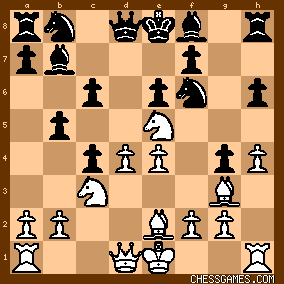
click for larger view After this, I wondered about 11. .. b4 12. Na4 Nxe4 for black. After investigation, I've come to the conclusion that moves 11-12 are not good for black: chessbase gives 6 white wins, no draws, and one black win; and this includes some grandmaster play. Some trial games I played show that White can come out of this very strongly. So, I conclude: if I'm playing Black here, I am not going to play 11. ... b4 and 12. ...Nxe4 |
|
| Oct-28-10 | | rapidcitychess: Good Evening: I've gotten rather sick of the usual pawn structures in queen pawns openings. On this page, it was said that the Slav leads to shattered pawn structures, queen sac, and sharp play. Could anyone point me to a couple odd lines in the Slav? Ever since I saw a couple off beat lines in the Botvinnik (e.g 11.Nxg5 Nd5!?) I've been looking for sharp lines in the Slav that aren't played often. |
|
| Oct-28-10 | | acirce: Do you mean the Slav, the Semi-Slav or both? Well, here's a taste. 1. d4 d5 2. c4 c6 3. Nf3 Nf6 4. Nc3 dxc4 5. a4 Bf5 6. Ne5 e6 7. f3 Bb4 8. e4 Bxe4 9. fxe4 Nxe4 10. Bd2 Qxd4 11. Nxe4 Qxe4+ 12. Qe2 Bxd2+ 13. Kxd2 Qd5+ 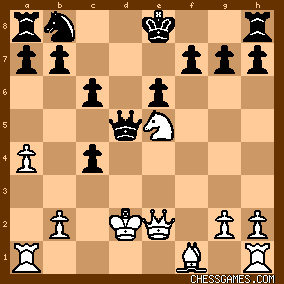
click for larger view1. d4 d5 2. c4 c6 3. Nf3 Nf6 4. Nc3 dxc4 5. a4 Bf5 6. Ne5 e6 7. f3 c5 8. e4 cxd4 9. exf5 Nc6 10. Nxc6 bxc6 11. fxe6 fxe6 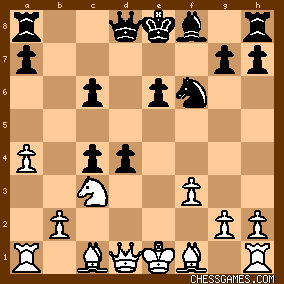
click for larger view1. d4 d5 2. c4 c6 3. Nf3 Nf6 4. Nc3 dxc4 5. a4 Bf5 6. Ne5 Nbd7 7. Nxc4 Qc7 8. g3 e5 9. dxe5 Nxe5 10. Bf4 Nfd7 11. Bg2 g5 
click for larger view1. d4 d5 2. c4 c6 3. Nf3 Nf6 4. Nc3 dxc4 5.e4 b5 6. e5 Nd5 7. a4 e6 8. axb5 Nxc3 9. bxc3 cxb5 10. Ng5 Bb7 11. Qh5 
click for larger view1. d4 d5 2. c4 c6 3. Nf3 Nf6 4. Nc3 dxc4 5. a4 e6 6. e4 Bb4 7. e5 Nd5 8. Bd2 b5 9. axb5 Bxc3 10. bxc3 cxb5 11. Ng5 
click for larger view1. d4 d5 2. c4 c6 3. Nf3 Nf6 4. Nc3 dxc4 5. a4 Bf5 6. e3 e6 7. Bxc4 Bb4 8. O-O Nbd7 9. Qe2 Bg6 10. e4 Bxc3 11. bxc3 Nxe4 12. Ba3 Qc7 
click for larger view1. d4 d5 2. c4 c6 3. Nf3 Nf6 4. Nc3 e6 5. e3 Nbd7 6. Qc2 Bd6 7. g4 Nxg4 8. Rg1 f5 9. h3 Ngf6 10. Rxg7 Ne4 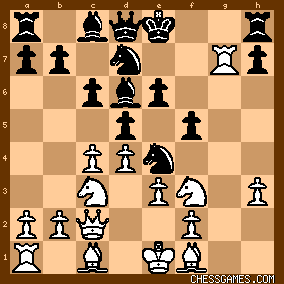
click for larger view1. d4 d5 2. c4 c6 3.Nf3 Nf6 4.Nc3 e6 5. Bg5 dxc4 6. e4 b5 7. e5 h6 8. Bh4 g5 9. Nxg5 hxg5 10. Bxg5 Nbd7 11. g3 Bb7 12. Bg2 Qb6 13. exf6 
click for larger view1. d4 d5 2. c4 c6 3. Nf3 Nf6 4. Nc3 e6 5. Bg5 h6 6. Bh4 dxc4 7. e4 g5 8. Bg3 b5 9. Be2 Bb7 10. O-O Nbd7 11. Ne5 Bg7 12. Nxf7 
click for larger view1. d4 d5 2. c4 c6 3. Nf3 Nf6 4. Nc3 e6 5. e3 Nbd7 6. Bd3 dxc4 7. Bxc4 b5 8. Bd3 Bb7 9. O-O a6 10. e4 c5 11. d5 
click for larger view1. d4 d5 2. c4 c6 3. Nf3 Nf6 4. Nc3 a6 5. c5 Bf5 6. Qb3 Ra7 7. Bf4 Nbd7 8. h3 h6 9. e3 g5 
click for larger view |
|
| Oct-28-10 | | acirce: 1. d4 d5 2. c4 c6 3. Nf3 dxc4 4. e3 b5 5. a4 e6 6. axb5 cxb5 7. b3 Bb4+ 8. Bd2 Bxd2+ 9. Nbxd2 a5 10. bxc4 b4
click for larger view1. d4 d5 2. c4 c6 3. Nc3 e5 4. dxe5 d4 5. Ne4 Qa5+ 6. Nd2 Nd7 7. e6 Ne5 
click for larger view1. d4 d5 2. c4 c6 3. Nf3 Nf6 4. Nc3 dxc4 5. a4 Bg4 6. Ne5 Bh5 7. f3 Nfd7 8. Nxc4 e5 9. e4 Qh4+ 10. g3 Qf6 11. dxe5 Qxf3 12. Nd6+ Kd8 13. Qxf3 Bxf3 14. Nxf7+ Ke8 15. e6 
click for larger view |
|
| Oct-28-10 | | rapidcitychess: <acirce>
I'll look these over... Some of them I've seen, others not. Very interesting... Thank you. |
|
| Apr-26-11 | | Amarande: 5 Bf4 - viable? This has VERY few tries in the Opening Explorer, and I'm not sure why it's turned out so badly for White. It also seems to lead to some very interesting variations, e.g. if Black would like to try the simple pin of White's Nc3, he actually is in for woolly complications: 5 ... Nbd7 6 e3 Bb4 7 Qc2 Qa5 8 Bd3! (The first surprise for Black here - this move is almost completely unplayable in the similar looking Cambridge Springs, and gives rise to many of its traps, but here it is very strong indeed, as Black has no 5-rank discovery.) dxc4?! 9 Bxc4 Ne4?! 
click for larger viewA very double edged move but is pretty much obligate after 8 ... dxc4?!, the only good purpose of which with the White DSB at f4 was to prepare this tactic. If Black tries the simple 9 ... O-O then White simply would play the LSB back to d3, then e4-e5 etc. and Black is likely to find his King crushed into dust. As it is, he STILL must be on his guard for having his King crushed into dust, e.g. - 10 O-O! <10 Qxe4 is doubtful; 10 ... Bxc3+ wins a Pawn *and* deprives White of castling to boot.> Bxc3 <Apparently best. If 10 ... Nxc3 then 11 a3! before recapturing the Knight, and White has central superiority and a good game, and Black does not even win his Pawn.> 11 Qxe4! <MUCH more to the point than meekly retaking the Bishop, particularly as Black there still wins a Pawn, with better chances.> Bxb2(?) <This may be ill advised - despite Rybka 2 seeing this as better than Bb4, the latter seems to be much more resilient and after this White gets a terrific attack.> 12 Rab1 Ba3 <Apparently better than 12 ... Bc3 after which White's Bishop drives home into d6 and leaves Black's King in no small amount of danger against potential schemes with Ng5 followed by a sac at e6 or f7, which as we shall see are dangerous enough!> 13 Ng5! |
|
| Apr-26-11 | | Amarande: 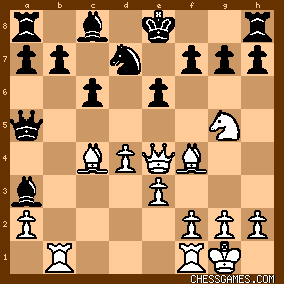
click for larger view<Virtually forcing Black to move his Knight; the threat is 14 Bxe6, after which to take the Bishop leaves Black the Exchange and a Pawn down: 14 ... fxe6 15 Qxe6+ Kd8 (Kf8?? 16 Qf7#, or Be7?? 16 Qf7+ Kd8 17 Ne6#) 16 Nf7+ and snags the Rook, and Black's game is ruined. But it's clearly also ruined if he doesn't take the Bishop ...> Nb6 <Nf6 or Nf8 may be worth considering? Of course 13 ... O-O?? 14 Qxh7#> 14 Bd3 Be7 <Because trying to play for King-side castling fails and seems to lose by force, despite the fact that Rybka 2 STILL claims a small advantage for Black here it might be better to play Bd7 and play for Queen's side castling, despite the attendant dangers? The B at d7 protects against Boden's mates at least ...> 15 h4! <Grabbing the h-pawn is bad, 15 ... g6 and the Knight has no escape> h6? 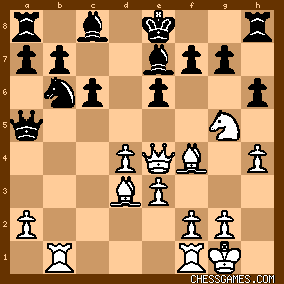
click for larger view<This attempt is definitely faulty, and leads directly to the loss of the game. An improvement is necessary here, but I'm now not sure what.> 16 Nxf7!! Kxf7 17 Qg6+ Kf8 18 Be5 Rg8 <Forced. If Bf6 then either 19 Bd6+ or 19 Bxf6 are both quite sufficiently lethal. But now Black's King is bottled up, and there is no defence that can last long.> 19 f4 Nd5 20 f5 and the f-file opening is fatal; serious loss can no longer be averted by Black. 20 ... Bf6 is already a forced mate after 21 fxe6 Bxe6 22 Rxf6+!; if 20 ... exf5 21 Bxf5 Nf6 22 Bxc8 and the QR finally crashes through through b7; 20 ... Nf6 holds out the longest, but Black still succumbs to mate or serious material loss no matter how he plays. E.g. 21 Bc4 Qd8 22 fxe6 Qe8 23 Qh7! Qh5 24 Rf5 with mate or loss of Queen, e.g. 24 ... Qg4 25 Rxf6+! Bxf6 26 Bd6+ Be7 27 Rf1+ followed by mate. 5 ... Bd6 has also been tried, and seems to give the best result for Black so far, but very few games have been played with 5 Bf4 so it is hard to say (indeed, I'm not sure how this move can be any other than faulty, as after 6 Bxd6 White rids himself of his worse Bishop and leaves Black stuck with his). There is also the gambit-accepted, 5 ... dxc4, which is also complicated e.g. 6 e3 b5 7 a4 Nd5 8 axb5 cxb5 9 Nxb5 Bb4+ with a wild gambit after 10 Nc3 Nxc3 11 bxc3 Bxc3+ 12 Nd2 Bxa1 13 Qxa1 - Black is the Exchange and a Pawn up, but Pc4 is untenable and he has NO development, while White has several pieces already developed. Rybka 2 gives only a *slight* advantage for Black after 13 ... O-O and as we saw in the previous complicated variation it seems that computer assessment here is dubious at best. A variation worth investigating, perhaps? 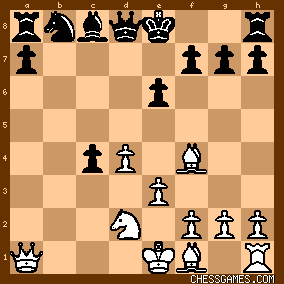
click for larger view |
|
Mar-09-12
 | | Penguincw: Opening of the Day
Opening of the Day
Semi-Slav
1.d4 d5 2.c4 e6 3.♘c3 ♘f6 4.♘f3 c6

click for larger view |
|
Jan-16-22
 | | saffuna: 1.d4 d5 2.c4 e6 3.♘c3 ♘f6 4.♘f3 c6 5. Bg5 dxc4 6. e4 b5 Is 7. a4 considered an acceptable move? |
|
 |
 |
|
< Earlier Kibitzing · PAGE 3 OF 3 ·
Later Kibitzing> |





